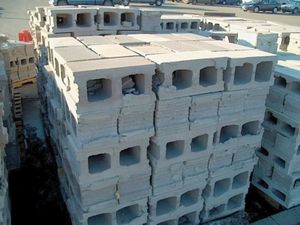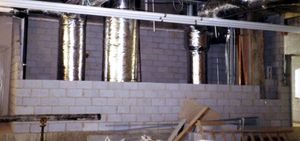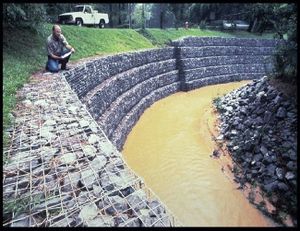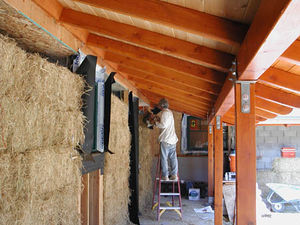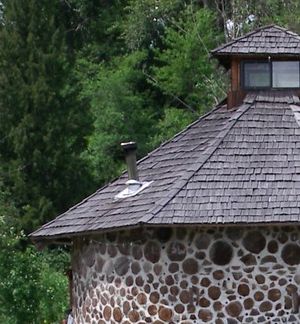Wall Materials
Jump to navigation
Jump to search
There are many alternatives to bricks & cement for walls. Each one has its own set of properties.
More popular wall types
Concrete Blocks
- Dense blocks
- Aerated blocks (generally known as breeze blocks, although the original blocks made of breeze are now obsolete)
- Hollow blocks
- Patterned blocks
- Decorative blocks
- Making Concrete Blocks
Reconstituted Stone Blocks
- Stone chips or dust, cement & pigment.
- aka cast stone
Timber Frame
- Exterior walls consisting of structural timber frame with infill or cladding
- Infill may be:
- wattle & daub
- earth, lime or cement mortar
- brickwork
- cladding may be:
- weatherboard
- plywood
- render
Stud walls
- Interior framed walls
- Wood or steel frame, plus
- Walling sheets, any of:
- Plasterboard (the usual choice)
- Lath & Plaster
- Clayboard
- Fibre cement sheet
- Fibreboard & hardboard occasionally found, but not recommended
Lime
- Lime & sand mortar with various building blocks
- standard mortar on historic buildings
- Sometimes used on new builds
- white appearance
- lower embodied energy than cement
- disposed of lime mortar becomes a normal part of the soil (chalk), thus eliminating the waste issue of cement mortars
- lower compressive strength makes it unsuitable for high rise buildings
- Non-hydraulic lime is very slow setting, and can be stored unset indefinitely if air is excluded
- Hydraulic lime is quick to set
Gabions
- Steel mesh cage
- Filled with stone
- Useful for retaining walls
- Widely used to retain river banks
Stone
- Types of stone wall:
- Sawn (smooth faced blocks)
- Hammer dressed (rough faced blocks)
- Rubble walls (meaning random sized uncut stone rather than the modern usage of the word)
- Dry stone walling (no mortar used)
Poured concrete
- Poured into wooden forms in situ
Glass brick
- Transmits light
- Poor Insulation
- White cement mortar usually used for joints
Strawboard
- A one piece sandwich of plaster, card, straw, card, plaster
- Low cost
- Good sound insulation
- Very poor strength, which can make fixing things to the wall problematic
- Poor strength makes it possible to fall through one of these walls
- Used between bedrooms in some cut price modern builds
- Brand name Stramit
Less popular wall types
Steel frame
- Light steel frame used for residential houses
- Steel frame is known for problem from the WW2 era
- Heavy duty steel framing used for skyscrapers - probably not many DIYers building skyscrapers though
Dry Block Walls
- Concrete blocks are stacked with no mortar
- Wall is then covered with glass fibre reinforced render
- The render is a structural element
- Quicker & weaker than a mortar laid block wall
Adobe
- Clay suboil, sand, straw or dung etc
- Blocks
Cob
File:Home at Hollyhock.jpg
Modern Cob house
- Subsoil, sand, straw, lime
- Continuous construction, no blocks involved.
- Wikipedia
Cast Earth
- Subsoil & gypsum
- More info
Sprayed Concrete
- Concrete is sprayed onto a form
- When the equipment is available this is a very fast construction method, typically used for emergency housing after natural disasters.
- Curvy artistic shapes are readily achieved with sprayed concrete
Papercrete
- Mixture of paper, cement, sand, subsoil, plus assorted optional additives
- Papercrete blocks stacked with papercrete mortar and papercrete render
- Lath rendered with papercrete is another way to build papercrete walls
- Many mix variations, some giving high insulation, high strength, or waterproofness.
- A wide range of waste materials can be incorporated into papercrete.
Earthcrete
- Subsoil & cement
- Good for paths
Superadobe
- Bags filled with stabilised earth used as building blocks
- Barbed wire included in wall joints for earthquake resistance.
- http://www.calearth.org/
Rammed Earth
- Aka pise de terre
- Earth, sand, gravel, clay
- A stabiliser is also needed in our wet climate, such as cement, lime or animal blood.
- Continous build, no blocks
Roman concrete
- Lime, pozzolan, sand & stone.
Sod
- Turf strips are stacked.
- Contains topsoil, grass and roots.
- The plant fibres stabilise & reinforce the soil
- Rendered, often with mud plaster.
- A low material cost walling option if enough grassed ground is available
- Earth constructions require large roof overhang to keep them sufficiently dry
Straw Bale
- Bales are stacked & the wall plastered
- Bales may be load bearing, or a separate wood frame can be used with bale infill.
- Very low cost
- Very fast construction method
- High thermal insulation
- Excellent sound absorption.
- Leaks must be repaired immediately to avoid rot
- Can be built by children
- Makes very thick walls
- Render & plaster cover prevents combustion
Rice hull bag walls
- Steel mesh forms each side of the wall
- Space filled with polypropylene bags of rice husks
- Barbed wire included in courses
- Good insulation
- Quick construction
Mudbrick
- Unfired clay bricks
- Short life expectancy, around 30 years
Earthship
- Stacked tyres filled with rammed earth
- No material cost
- Rather ugly in most people's view
- Bulky
- Flammable
Drinks can walls
- Interior non loadbearing wall
- Drink cans are stacked with wet concrete between them, forming a concrete lattice wall
- Wall is plastered, the plaster attaches to the ring pulls
Hollow Ceramic Blocks
- Lightweight lattice-like fired clay blocks are stacked
- Wall then rendered
Ceramic Pots
- Plant-pot like ceramic pots are stacked
- Wall then rendered
- Popular in Spain
Half Timbered
- Vertical wood studs with close spacing
- Mud plaster infill
- Historic construction method for external walls
Wattle & Daub
- Timber stud framework
- Woven twig fencing panels (wattle)
- Plastered with mud plaster (daub)
- Historic construction method for internal & external walls
Cordwood
- Almost never seen in the UK
- Requires large amounts of logwood
- Walls consist of horizontal logs bedded in mortar at each end. The logs run from inside to out rather than along the wall.
- Cordwood is thus a bridged cavity construction
- More info
